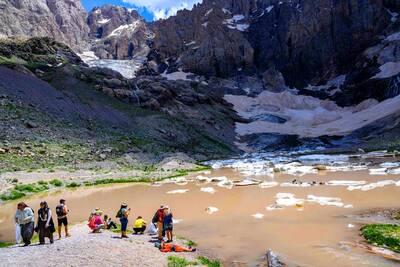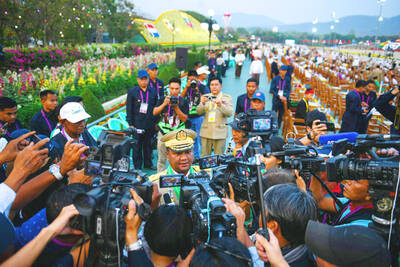Discovering there is intelligent life beyond our planet could be the most transformative event in human history — but what if scientists decided to collectively ignore evidence suggesting it already happened?
That is the premise of a new book by a top astronomer, who argues that the simplest and best explanation for the highly unusual characteristics of an interstellar object that sped through the solar system in 2017 is that it was alien technology.
Sound kooky? Avi Loeb said the evidence holds otherwise, and is convinced that his peers in the scientific community are so consumed by groupthink they are unwilling to wield Occam’s razor.

Photo: Lotem Loeb / AFP
Loeb’s stellar credentials — he was the longest-serving chair of astronomy at Harvard University, has published hundreds of pioneering papers and has collaborated with greats such as the late Stephen Hawking — make him difficult to dismiss outright.
ARROGANT THINKING
“Thinking that we are unique and special and privileged is arrogant,” he said. “The correct approach is to be modest and say: ‘We’re nothing special, there are lots of other cultures out there, and we just need to find them.’”
Loeb, 58, lays out the argument for the alien origins of the object named ‘Oumuamua — “scout” in Hawaiian — in Extraterrestrial: The First Sign of Intelligent Life Beyond Earth.
In October 2017, astronomers observed an object moving so quickly, it could only have come from another star — the first recorded interstellar interloper.
It did not appear to be an ordinary rock, because after passing around the sun, it sped up and deviated from the expected trajectory, propelled by a mysterious force. This could be easily explained if it was a comet expelling gas and debris — but there was no visible evidence of this “outgassing.”
The traveler also tumbled in a strange way — as inferred by how it became brighter and dimmer in scientists’ telescopes, and it was unusually luminous, possibly suggesting it was made from a bright metal.
In order to explain what happened astronomers had to come up with novel theories, such as it was made of hydrogen ice and would therefore not have visible trails, or that it disintegrated into a dust cloud.
“These ideas that came to explain specific properties of ‘Oumuamua always involve something that we have never seen before,” Loeb said. “If that’s the direction we are taking, then why not contemplate an artificial origin?”
‘Oumuamua was never photographed close-up during its brief sojourn — we only learned of its existence once it was already on its way out of our solar system.
There are two shapes that fit the peculiarities observed — long and thin like a cigar, or flat and round like a pancake, almost razor thin.
Loeb said that simulations favor the latter, and believes the object was deliberately crafted as a light sail propelled by stellar radiation.
Another oddity was the way the object moved — compounding the strangeness of its passage.
A BUOY
Before encountering the sun, ‘Oumuamua was “at rest” relative to nearby stars — statistically very rare. Rather than think of it as a vessel hurtling through space, from the object’s perspective, the solar system slammed into it.
“Perhaps ‘Oumuamua was like a buoy resting in the expanse of the universe,” Loeb wrote.
Like a trip wire left by an intelligent lifeform, waiting to be triggered by a star system.
Loeb’s ideas have placed him at odds with fellow astronomers.
Writing in Forbes, astrophysicist Ethan Siegel called Loeb a “once-respected scientist” who, having failed to convince his peers of his arguments, had taken to pandering to the public.
Loeb, for his part, protests a “culture of bullying” in the academy that punishes those who question orthodoxy — just as Galileo was punished when he proposed the Earth was not the center of the universe.
Compared to speculative yet respected branches of theoretical physics — such as looking for dark matter or multiverses — the search for alien life is a far more commonsense avenue to pursue, he said.
That is why Loeb is pushing for a new branch of astronomy, “space archeology,” to hunt for the biological and technological signatures of alien life.
“If we find evidence for technologies that took a million years to develop, then we can get a shortcut into these technologies; we can employ them on Earth,” Loeb said.

In the sweltering streets of Jakarta, buskers carry towering, hollow puppets and pass around a bucket for donations. Now, they fear becoming outlaws. City authorities said they would crack down on use of the sacred ondel-ondel puppets, which can stand as tall as a truck, and they are drafting legislation to remove what they view as a street nuisance. Performances featuring the puppets — originally used by Jakarta’s Betawi people to ward off evil spirits — would be allowed only at set events. The ban could leave many ondel-ondel buskers in Jakarta jobless. “I am confused and anxious. I fear getting raided or even

POLITICAL PATRIARCHS: Recent clashes between Thailand and Cambodia are driven by an escalating feud between rival political families, analysts say The dispute over Thailand and Cambodia’s contested border, which dates back more than a century to disagreements over colonial-era maps, has broken into conflict before. However, the most recent clashes, which erupted on Thursday, have been fueled by another factor: a bitter feud between two powerful political patriarchs. Cambodian Senate President and former prime minister Hun Sen, 72, and former Thai prime minister Thaksin Shinawatra, 76, were once such close friends that they reportedly called one another brothers. Hun Sen has, over the years, supported Thaksin’s family during their long-running power struggle with Thailand’s military. Thaksin and his sister Yingluck stayed

Kemal Ozdemir looked up at the bare peaks of Mount Cilo in Turkey’s Kurdish majority southeast. “There were glaciers 10 years ago,” he recalled under a cloudless sky. A mountain guide for 15 years, Ozdemir then turned toward the torrent carrying dozens of blocks of ice below a slope covered with grass and rocks — a sign of glacier loss being exacerbated by global warming. “You can see that there are quite a few pieces of glacier in the water right now ... the reason why the waterfalls flow lushly actually shows us how fast the ice is melting,” he said.

RESTRUCTURE: Myanmar’s military has ended emergency rule and announced plans for elections in December, but critics said the move aims to entrench junta control Myanmar’s military government announced on Thursday that it was ending the state of emergency declared after it seized power in 2021 and would restructure administrative bodies to prepare for the new election at the end of the year. However, the polls planned for an unspecified date in December face serious obstacles, including a civil war raging over most of the country and pledges by opponents of the military rule to derail the election because they believe it can be neither free nor fair. Under the restructuring, Myanmar’s junta chief Min Aung Hlaing is giving up two posts, but would stay at the